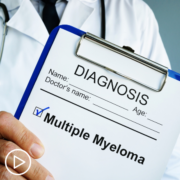Understanding MGUS, Smoldering and Multiple Myeloma
Understanding MGUS, Smoldering and Multiple Myeloma from Patient Empowerment Network on Vimeo.
What is the difference between smoldering myeloma and monoclonal gammopathy of undetermined significance (MGUS)? Dr. Mark Schroeder defines these diagnoses and discusses how asymptomatic myeloma is monitored.
Dr. Mark Schroeder is a hematologist at Siteman Cancer Center of Washington University School of Medicine in St. Louis. Dr. Schroeder serves as Associate Professor in the Department of Medicine. Learn more about Dr. Schroeder.
See More from Engaging in Myeloma Treatment Decisions
Related Resources:

|

|

|
Transcript:
Katherine Banwell:
As a patient, engaging in your care starts with understanding your diagnosis, so I’d like to go through some definitions. What is multiple myeloma?
Dr. Mark Schroeder:
Multiple myeloma is a blood cancer. It’s a cancer in particular of a blood cell called a plasma cell. Everybody has normal plasma cells in their body. It’s part of your immune system that responds to infections; they are also cells that respond to vaccinations.
And when a plasma cell becomes a cancer, it often forms a cancer called multiple myeloma. And that cancer results oftentimes in damage to bones, low blood counts or anemia, potentially kidney problems, or possibly seeing high levels of calcium.
Katherine Banwell:
What about smoldering myeloma? What is that?
Dr. Mark Schroeder:
So, smoldering myeloma is a stage that happens prior to the development of myeloma that is causing organ damage. I talked about the damage to bones, kidneys, blood cells – that is called the CRAB criteria. The C stands for calcium, the R renal, A anemia, and B bones. We define myeloma by having damage to one of those four essential systems.
Smoldering myeloma can happen when we actually see plasma cells that look like myeloma – that look like cancer cells, but they’re not causing the CRAB features of multiple myeloma. And there is a chance that sometimes that smoldering form of myeloma, it’s not causing any damage, but it can evolve and change into myeloma.
Katherine Banwell:
What is MGUS?
Dr. Mark Schroeder:
MGUS is a stage that happens prior to smoldering myeloma. We know that MGUS which stands for monoclonal gammopathy of undetermined significance – it’s a mouthful. That’s why we like to say MGUS.
Katherine Banwell:
Yes.
Dr. Mark Schroeder:
But it’s a protein that can be detected in your blood. Sometimes that protein does not mean you have a cancer. We can detect proteins like that in blood in patients who have, say, autoimmune diseases, and they’re at low levels. It’s just an immune response; it’s produced by those plasma cells that can be cancerous, but sometimes plasma cells grow because they’re stimulated – they’re overstimulated.
And so, that monoclonal protein of MGUS can be detected in the blood, but we don’t see an increase in the number of cells in the bones that are classic for myeloma. But we know that about 1 percent of patients who have MGUS, every year, 1 percent might progress on to develop multiply myeloma. So, it’s a risk factor; it’s on the spectrum of disease from MGUS to smoldering myeloma to myeloma.
Katherine Banwell:
Okay. And how is asymptomatic myeloma monitored?
Dr. Mark Schroeder:
So, asymptomatic patients, I would consider those are the patients who have smoldering myeloma, so they don’t have the high calcium, the renal issues, anemia, or bone problems. And typically, those patients are followed up about every three to six months, depending on where they fit in kind of that spectrum of MGUS to smoldering myeloma to myeloma.
Sometimes patients who have clinically identified myeloma and it presents very heterogeneous sometimes. They may not have a lot of organ involvement or organ damage, and maybe they’re frail, they’re elderly. And it may be appropriate also to observe patients who actually have some of the findings of myeloma, but the disease doesn’t seem to be as aggressive.



